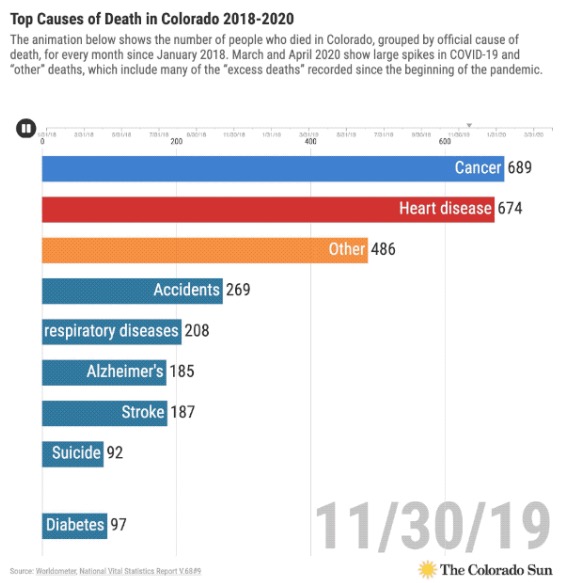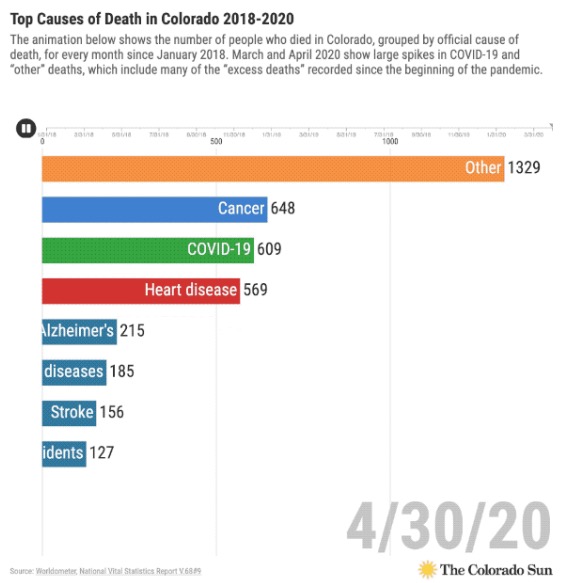Yesterday in Part One, we noted some dramatic changes in the ’causes of death’ data reported by the state of Colorado as the shadow of the COVID-19 pandemic spreads across the US. We shared several screen shots from an animated graphic included by reporter John Ingold in his May 21 Colorado Sun article titled, “Colorado likely won’t have an accurate coronavirus death count for months, or even years”.
The article subheading reads:
17% more deaths occurred in Colorado in March and April compared to last year — and only a fraction are listed as COVID-19 victims. Here’s what we know about the “excess deaths.”
Here, again, is the screenshot from the Colorado Sun graphic, showing the ‘leading causes of death’ in Colorado last November:
The number-one reported killer in Colorado during the month of November was “Cancer,” followed by “Heart disease”. We also note many people reportedly dying from “Accidents”, “Chronic lower respiratory diseases”, “Alzheimer’s” and “Stroke”. But the folks who track this stuff also have a catch-all category for deaths caused by conditions that don’t fit into the “15 leading causes of death.”
This category is “All other causes (residual)”… shown in the Colorado Sun graphic as “Other”. Through the months of 2019 and into the spring of 2020, “Other” accounted for somewhat fewer deaths than “Heart disease”… and somewhat more than “Accidents”.
As we will see shortly, this category appears to include “Deaths due to an unknown cause.”
Many, many years ago… before the invention of the ‘Germ Theory’ and the discovery of the bacteria and viruses that now get blamed for certain types of disease… and before the arrival of modern technology — blood pressure monitors, X-ray images, MRI scans, dialysis machines, ventilators, portable blood glucose meters… and before the creation of the National Center for Health Statistics…
… people generally accepted the idea that there existed a ’cause of death’ known as “Old age.” But that category doesn’t appear in the NCHS list of “leading causes of death.” Our health officials, these days, are expected to pick out one specific cause — Cancer, Stroke, Diabetes, Heart disease, Pneumonia, Kidney failure — and inscribe it on a death certificate, to keep the statistical wheels turning.
And perhaps, to keep us all on our toes, and watching out for an probable cause?
I think of my dear mother, one of the sweetest people you could ever hope to meet, who passed away a few years ago at the ripe old age of 92. She was suffering from a catalog of ailments during her last years of life. Diabetes. High blood pressure. Kidney failure. Dementia. Gum disease. Hair loss. Her colon had been surgically removed several years earlier in a rude attempt to control chronic intestinal pain.
She had somehow maintained a generally cheerful disposition, and she continued to ingest a range of pharmaceutical drugs to treat her various chronic conditions. The staff at the nursing home had learned to deal with her occasional fits of bad temper. They kept careful track of her blood glucose levels and gave her an injection of insulin when necessary.
One morning, she woke early and climbed out of bed to sit in her favorite easy chair, and drifted off. Permanently.
I have no idea what “cause of death” was entered on her death certificate, to be later reported to the folks who track those statistics. Kidney failure? Diabetes? Alzheimer’s? Stroke? Some type of organ failure? Bacterial infection?
I’m not a doctor or a scientist, but it seems to me the most reasonable “cause of death” choice — if you really must make a choice about my mother’s passing — would be, very simply, “Old age.” But that choice seems to be missing from the catalog of specific selections, in 2020.
Unless… perhaps… it is included in the category known as “All other causes (residual)”?
According to the animated graphic shared in John Ingold’s Colorado Sun article last week, the number of Colorado deaths categorized as “Other” exploded in April.
Normally, in NCHS rankings, the category “Other” is found somewhere between “Heart disease” and “Accidents.” In April 2020, a new category — “COVID-19” — appears in Mr. Ingold’s graphic. But the more startling change, it seems to me, is the huge increase in the number of Colorado deaths categorized as “Other”. This category now surpasses all other causes… by a huge margin.
From Mr. Ingold’s article:
Across Colorado, there is a mystery brewing in mortality.
At least 1,200 more people died last month in the state compared to April 2019, according to official — though preliminary — figures. But only a fraction of that increase is currently being attributed to the novel coronavirus.
So, in a time of unprecedented public health crisis and unprecedented restrictions on travel, what else is killing Coloradans?
Yes, what else is killing Coloradans? We currently have no explanation, apparently, for the massive increase in “Other” death reports. Is this “something else” actually SARS-CoV-2 infections that don’t look like what we expect them to look like?
This is a loaded question, politically, as a divided nation argues about a pandemic that no one yet understands fully. Will COVID-19 eventually prove to be many times more deadly than recent influenza epidemics? Is the economic damage from ‘staying at home’ more harmful than the disease itself? Does wearing a face covering actually do any good?
The mystery of the “excess” deaths in the spring of 2020 — “excess”, that is, in the normal process of reckoning ’cause of death’ data — may never be fully explained.
Or maybe it will?
One of the most notable effects of modern medicine has been its ability to keep elderly people alive. As a result, nations all around the globe now find themselves with growing numbers of chronically ill, often disabled older folks no longer able to care for themselves — shuffled off into nursing homes in many cases, and creating an economic burden on younger, still-productive sectors of the population.
We’re all aware of this fact… but how many of us are willing to openly discuss it?


